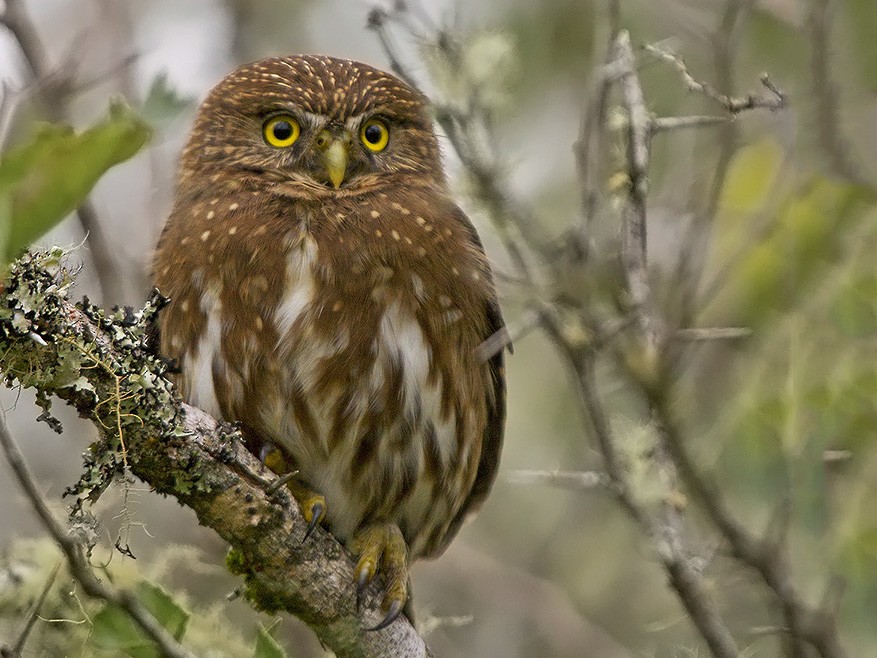
The 18 most-wanted birds in North America
Ferruginous Pygmy-Owl
1. Ferruginous Pygmy-Owl is the Spud Webb of birds. Webb, all five feet seven inches and 133 pounds of him, played 12 seasons in the NBA, in which the average player is a foot taller and 90 pounds heavier. The pygmy-owl is no bigger than a bluebird and weighs about 2.5 ounces, yet it has been known to prey on the larger and significantly heavier Gambel’s Quail and hispid cotton rat. 2. Ferruginous Pygmy-Owl feeds mainly on grasshoppers and also eats scorpions, cicadas, reptiles, and birds. 3. A study conducted on the King Ranch in Texas recorded the owl preying on Northern Cardinal, Blue Grosbeak, Eastern Meadowlark, and other songbirds. 4. The owl uses a perch-and-pounce hunting method, and it raids nest cavities of Golden-fronted Woodpecker and other birds. 5. To fool its prey, Ferruginous Pygmy-Owl evolved so-called false eyes: patches of dark feathers on the back of its head that look like eyes. 6. In recent decades, the subspecies known as Cactus Ferruginous Pygmy-Owl declined substantially in Arizona and was listed as Endangered between 1997 and 2006. Last year, environmentalists filed suit calling for it to be listed again. 7. Unfortunately, populations across the border in Sonora, Mexico, dropped 36 percent from 2000 to 2009, according to a report by University of Montana biologist Aaron Flesch. 8. Unless Sonora’s numbers rebound, he writes, it’s unlikely that owls will be translocated from Sonora to Arizona to help the species recover in the state. 9. Another challenge: In the time when the species was listed but before critical-habitat protections took effect under the Endangered Species Act, many landowners near Tucson developed their land, making it much less suitable for owls. 10. Today the big bird-friendly ranches of South Texas are the best places to find Ferruginous Pygmy-Owl in the United States. Since floods along the Rio Grande in July 2010, the species has been absent from its traditional haunts near the Mexico border, including Bentsen-Rio Grande Valley State Park and Santa Ana National Wildlife Refuge.
1. Ferruginous Pygmy-Owl is the Spud Webb of birds. Webb, all five feet seven inches and 133 pounds of him, played 12 seasons in the NBA, in which the average player is a foot taller and 90 pounds heavier. The pygmy-owl is no bigger than a bluebird and weighs about 2.5 ounces, yet it has been known to prey on the larger and significantly heavier Gambel’s Quail and hispid cotton rat. 2. Ferruginous Pygmy-Owl feeds mainly on grasshoppers and also eats scorpions, cicadas, reptiles, and birds. 3. A study conducted on the King Ranch in Texas recorded the owl preying on Northern Cardinal, Blue Grosbeak, Eastern Meadowlark, and other songbirds. 4. The owl uses a perch-and-pounce hunting method, and it raids nest cavities of Golden-fronted Woodpecker and other birds. 5. To fool its prey, Ferruginous Pygmy-Owl evolved so-called false eyes: patches of dark feathers on the back of its head that look like eyes. 6. In recent decades, the subspecies known as Cactus Ferruginous Pygmy-Owl declined substantially in Arizona and was listed as Endangered between 1997 and 2006. Last year, environmentalists filed suit calling for it to be listed again. 7. Unfortunately, populations across the border in Sonora, Mexico, dropped 36 percent from 2000 to 2009, according to a report by University of Montana biologist Aaron Flesch. 8. Unless Sonora’s numbers rebound, he writes, it’s unlikely that owls will be translocated from Sonora to Arizona to help the species recover in the state. 9. Another challenge: In the time when the species was listed but before critical-habitat protections took effect under the Endangered Species Act, many landowners near Tucson developed their land, making it much less suitable for owls. 10. Today the big bird-friendly ranches of South Texas are the best places to find Ferruginous Pygmy-Owl in the United States. Since floods along the Rio Grande in July 2010, the species has been absent from its traditional haunts near the Mexico border, including Bentsen-Rio Grande Valley State Park and Santa Ana National Wildlife Refuge.
Advertisements
11 June 2022
Advertisements



